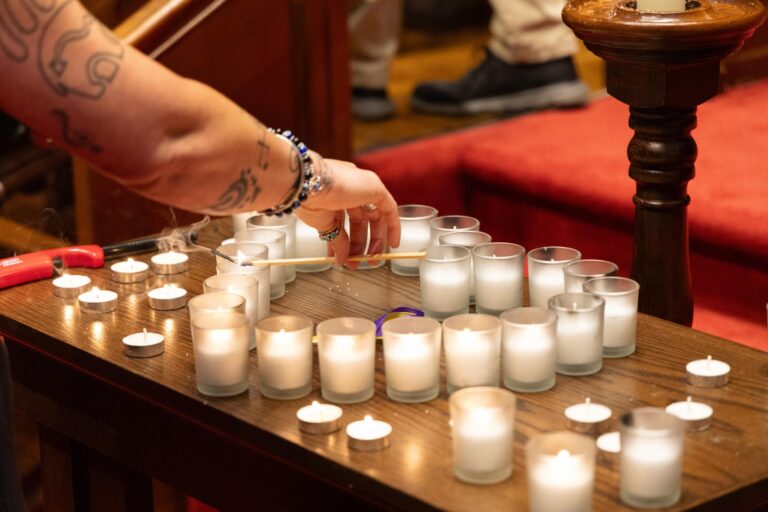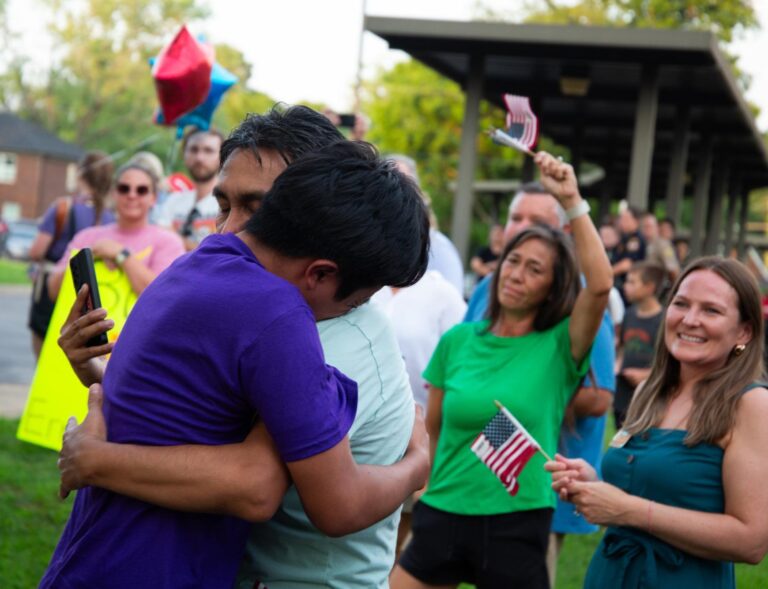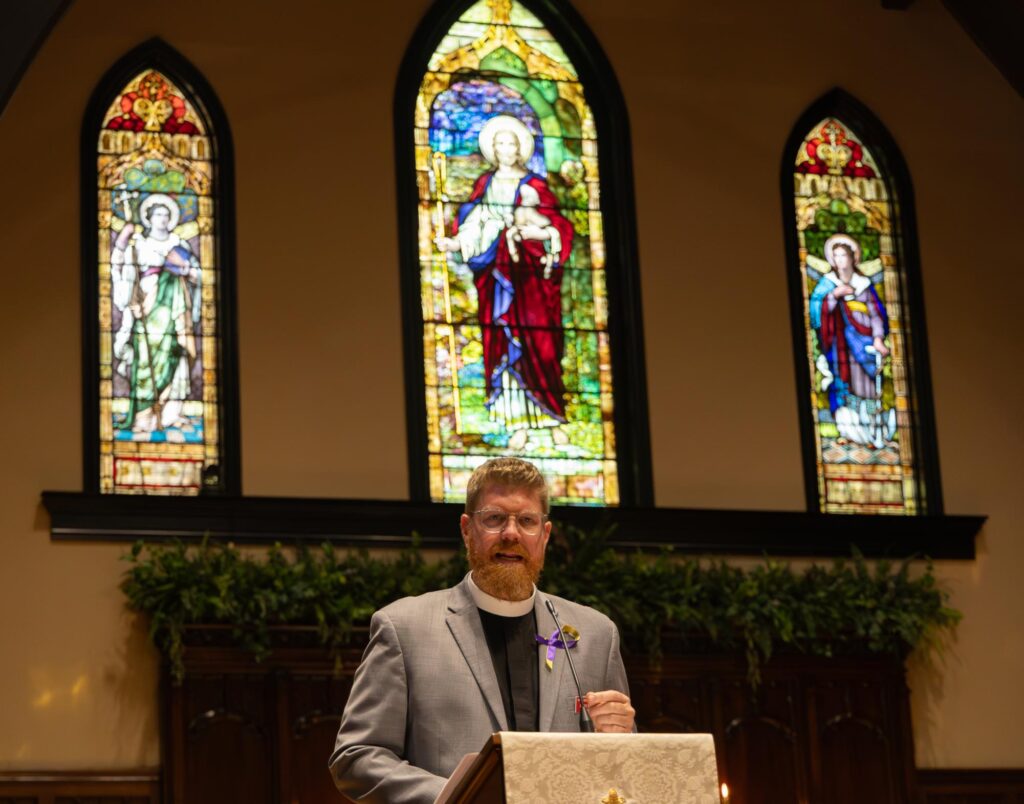After ICE Makes an Unjust Arrest – Reflections on an Emergency Prayer Vigil
The Rev. Dr. Steven Pankey is the Rector of Christ Episcopal Church of Bowling Green Kentucky and Vice-President of the House of Deputies of The Episcopal Church. He recently led a prayer vigil following the unjust arrest of a member of his community by ICE. The Rev. Canon Nurya Love Parish reached out to learn about his experience to inform religious leaders today. This interview has been lightly edited and condensed.
What happened to Ernesto that led to this prayer vigil being created?
Ernesto is an 18 year-old recent graduate from Bowling Green High who is in the US with Special Immigrant Juvenile status. This means he is legally here and has deferred action on any pending immigration claims. ICE was in his neighborhood looking for someone when they came across Ernesto’s father. They arrested him “collaterally” and made him take them to his home where they arrested Ernesto, also “collaterally” despite proof that he had legal status. He was sent to three different detention centers in 5 days, had no contact with an attorney, and he ended up in Monroe, LA. At that point he was able to get in touch with someone from one of the refugee resettlement agencies in our community. They connected him with an immigration law group and started a GoFundMe to raise money for his bond and legal costs.

How did you learn about Ernesto’s situation? Who brought it to your attention?
Ernesto’s situation had been in the paper and on the local news a couple of times before it really came to my attention. Then one of our city commissioners texted several friendly pastors to see if the church might have a voice in what had happened. They had already done a public demonstration/protest and were looking to expand their network. This city commissioner works in the Youth Services Center at Bowling Green Junior High School. Because she helps kids who can’t afford what they need, she is connected to the local pastor’s network.
How did you decide to hold a prayer vigil at your church?
The city commissioner was looking for a religious voice. Her idea was public fasting. She texted on Sunday afternoon, we had a Zoom on Monday morning and talked about what we thought might work. The consensus was that individual fasting might be a good thing, but we also needed to gather people in a place and draw media attention. We decided to do a prayer vigil or two. It turned out to be two – one on Tuesday night which we hosted and one on Thursday night which one of the United Methodist churches hosted. Friday, we called for a community-wide day of prayer and fasting.
What was the turnaround time between Ernesto being taken by ICE and the vigil – how long did you take to put it together?
Ernesto was arrested on June 4. He made contact on about June 9. The papers picked it up around the 11th or 12th and the text from the city commissioner came on the 15th. We met on the 16th, had a vigil on the 17th and the 19th and faith leaders did prayer and fasting on the 20th.
What other decision-makers were involved in making these plans?
On the call on the 16th was the City Commissioner, myself, the pastor of Broadway United Methodist Church that held the second prayer vigil and the pastor at State Street Baptist Church which is the historically Black Baptist church in town, who is also a Tennessee State Trooper. Our building had the earliest availability, so we held the vigil there, but others stayed included in a group text.
Who else was involved in putting together the prayer vigil? How did they become involved?
I told my staff that we were holding a prayer vigil, and I got put in touch with another pastor at Broadway UMC who helped me develop the liturgy. I also got a lot of help from the Rev. Susan Russell, whom I reached out to because she was a point person for work in Los Angeles. She sent me a litany from Episcopal Migration Ministries and another resource from the Episcopal Public Policy Network.
What did you do to make known that the prayer vigil was happening?
We released a Faith Leaders statement to the media to share our plans. We have two local news stations, WBKO/CBS and WNKY/NBC. We also sent it to the Bowling Green Daily News, our local print newspaper and the WKU Herald which is the western Kentucky newspaper. We also sent it to WKYU, our local NPR station. We pulled contact information from their websites where they ask for news tips. I sent them a “news tip” and linked the Faith Leaders statement.
Who else participated in leading the vigil?
The leaders were myself, our deacon the Ven. Kellie Mysinger who was the litanist, and we had one of Ernesto’s teachers tell us about Ernesto. Then two of the musicians from Broadway UMC helped lead music. The city commissioner wanted something photogenic, so we decided to light candles. We put out candles for people to light and say a prayer. We also put out paper and pens/pencils for people to write Ernesto notes of encouragement. (At this point we haven’t found a way to get those to him, but we’re working on it.) Here’s the bulletin.
Were any lawmakers invited and/or involved?
The city commissioner was integral to this. There was a city commission meeting that night, but she came afterwards as did another member of the city commission. Through contacts, we sent notice to someone who got it in front of the governor and our US Representative and both Senators also got notice of it.
How did you decide whom to invite/involve?
A lot of it was schedule driven. We had bodies and space available, so we did most of the heavy lifting for Tuesday. Our organist/choir director was out sick, so we needed music help. There was a group text for organizers, so we found help through that. Broadway UMC took the lead on Thursday when they had bodies and space.
Whom did you notice as attending the vigil?
About 100 people showed up on 26 hours notice, which is pretty impressive. About 20 of them were members of our church. The rest were people from the community who were concerned. A couple people said “we didn’t know churches did this kind of thing.” We had participants from four years old to 80 years old.
When others review your liturgy materials as inspiration for their own vigil, what would you want them to know? Specifically, what do you think worked well and did not work as well as you had hoped?
Because so often the people who are affected by ICE are not known to the people that have privilege they can use and wield on their behalf, it was super effective to have someone speak who knew Ernesto as a person. What I told that speaker was “He needs to be a human being to us, not a cause. We need to get to know him.”
Our goal was to have three speakers – one to help people know Ernesto, one to explain why we are here, one to explain the next steps from here. We couldn’t get all those people, so I took the second two ideas and turned them into one reflection.
I was surprised that more people participated in the interactive parts than I expected. If you are going to have candles or cards, have lots.
The service wasn’t modeled after an Episcopal service. It was meant to be responsive to the moment and the community, and to cast as broad a net as possible. I think that worked.
What have you experienced in the days since the vigil in terms of short-term impact on the conversations in your church and/or in your community?
Besides the two initial prayer vigils, one more prayer vigil was held yesterday morning at First Christian Church during the time when Ernesto’s bail hearing was supposed to take place. He did go before an immigration judge who granted him the minimum bail allowed by law, $1500, and then immediately the Department of Homeland Security filed notice of an intent to appeal the bond, which meant that bond can’t be paid until that appeal process is finalized. That is up to 30 days. He is still in custody despite a judge saying that he is not a flight risk, there is no reason to hold him, let’s get him out on minimum bail and let him live his life.
I think there was a shift in the congregations that participated in the prayer vigils. Even if our people weren’t there at the vigils, they knew about it eventually. Many of them then went to look up the story and figure out what was happening and learn just how awful the situation is. I preached about it on Sunday as well, so my folks had no choice but to hear about it. There is some talk about continuing the prayer vigils, but given the new intent to appeal, we have to strategize. One of the mentors from the refugee resettlement team said that dangling freedom in front of him only to snatch it away was unnecessarily, heart-breakingly cruel. We’re all kind of reeling from this new chapter in this situation and we need to rethink next steps.
What else would you want someone else to know if they have to do something like this?
I would want them to know that community partners are your friends.
It is really important to get to know not just that particular story of the arrest but also the larger narrative of the person’s life.
You will get pushback because people are taught to think that the government can do nothing wrong, so this person must be a criminal because only criminals get arrested. Expect pushback.
Expect to be surprised by how many people will care with you. I was surprised that 100 people showed up. I thought we might have 25.
Note: Since this interview, Ernesto was released in late June. According to a statement released by Fugees Family, the legal organization assisting his case, Manuel-Andres will remain out on bond, and his legal proceedings will continue. The organization asked for respect of the teens privacy from all media and that he will not give interviews while his case is pending.



